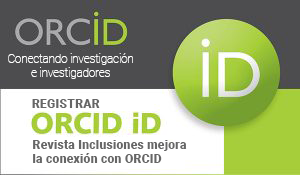REVISTA DE HUMANIDADES Y CIENCIAS SOCIALES
PUBLICATION GUIDELINES AND EDITING RULES OF REVISTA INCLUSIONES
(Updated to CMOS 17th Edition)
General Presentation of Articles:
Articles must not exceed 18,000 words (approximately 30-32 pages), including abstract, footnotes, and bibliography.
Articles must be presented in Arial font, size 12, single-spaced, with 3 cm margins on all sides (top, bottom, left, and right), justified. Documents are accepted in letter size (8.5 x 11 inches) or A4 (210 x 297 mm) format. In case of minor differences in text layout due to paper size, Revista Inclusiones will adjust the final format for electronic publication, ensuring consistency.
Notes will be placed in footnotes, in Arial font, size 10, single-spaced.
On the first page, an abstract in Spanish or the article’s original language must be included, with a maximum of 150 words.
The abstract must be analytical, presenting the article’s objectives, content, and results.
Following the abstract, a list of three to five keywords must be provided, preferably selected from the UNESCO Thesaurus (http://databases.unesco.org/thessp/) or another recognized thesaurus. It is recommended to consider terms relevant for search engine optimization (SEO) and reflective of current trends in the subject matter. The journal may suggest adjustments to maximize the article’s visibility.
The abstract, keywords, and title will be translated into English by Revista Inclusiones with the author’s authorization.
The author’s name must not appear in the article.
Author details must be submitted in a separate document, including name, email address, academic degree, institutional affiliation, and ORCID. This document must also indicate the research from which the article originates and how it was funded.
General Presentation of Reviews and Recensions:
Reviews and recensions must be presented single-spaced, in Arial font, size 12, with 3 cm margins on all sides (top, bottom, left, and right), justified. Documents are accepted in letter size (8.5 x 11 inches) or A4 (210 x 297 mm) format. Revista Inclusiones may make minor adjustments for electronic publication if necessary.
Editing Rules:
Subdivisions within the text (chapters, subchapters, etc.) must be numbered with Arabic numerals, except for the introduction and conclusion, which are not numbered.
Latin terms and foreign words must be italicized.
The first time an abbreviation is used, it must appear in parentheses after the full term; subsequent uses will employ only the abbreviation.
Quotations exceeding four lines must be presented in long quotation format, in quotation marks, single-spaced, in size 11 font, with reduced margins.
There must be a space between each paragraph; paragraphs will have no indentation.
Tables, graphs, illustrations, photographs, and maps must be referenced and explained in the text. They must be titled, sequentially numbered, and accompanied by their respective captions and source(s). They will be placed immediately following the paragraph where they are mentioned. Images must be submitted in digital format (JPG or TIFF, 300 and 240 DPI). It is the author’s responsibility to obtain and provide Revista Inclusiones with the necessary permissions for publishing images that require them.
Footnotes must be numbered with Arabic numerals.
At the end of the article, a bibliography will be included in Arial font, size 11, single-spaced. Bibliographic references must be listed alphabetically, including only works cited in the article, unless the author opts to include a broader bibliography.
References:
Revista Inclusiones uses an adaptation of the Chicago Manual of Style, 17th edition, Humanities version (notes and bibliography). Below are examples with the abbreviations "N" (footnotes) and "B" (bibliography):
Book by a Single Author:
N: First Name Last Name, Full Title (City: Publisher, year), 45.
B: Last Name, First Name. Full Title. City: Publisher, year.
(Note: In the 17th edition, the author’s full name may be used as it appears in the work, without inversion in the note if it feels more natural).
Book by Two Authors:
N: First Name Last Name and First Name Last Name, Full Title (City: Publisher, year), 45.
B: Last Name, First Name, and First Name Last Name. Full Title. City: Publisher, year.
Book by Three or More Authors:
N: First Name Last Name et al., Full Title (City: Publisher, year), 45.
B: Last Name, First Name, First Name Last Name, and First Name Last Name. Full Title. City: Publisher, year.
(Note: In notes, "et al." is used for four or more authors; in the bibliography, all authors are listed).
Article in a Book:
N: First Name Last Name, “Article Title,” in Full Title, ed. First Name Last Name and First Name Last Name (City: Publisher, year), 45-50.
B: Last Name, First Name. “Article Title.” In Full Title, edited by First Name Last Name and First Name Last Name, 45-50. City: Publisher, year.
Journal Article:
N: First Name Last Name, “Article Title,” Journal Title 10, no. 2 (year): 45.
B: Last Name, First Name. “Article Title.” Journal Title 10, no. 2 (year): 45-90.
(Note: "no." is used instead of "num" for the issue number).
Newspaper Article:
N: First Name Last Name, “Article Title,” Newspaper Title, City, March 15, 2025.
B: Last Name, First Name. “Article Title.” Newspaper Title, City, March 15, 2025.
Thesis:
N: First Name Last Name, “Thesis Title” (undergraduate/master’s/doctoral thesis, University, year), 45-50.
B: Last Name, First Name. “Thesis Title.” Undergraduate/Master’s/Doctoral thesis, University, year.
Archival Sources:
N: “Document Title,” place and date (if applicable), in Archive Acronym, Section, Fund, vol./leg./t., f. or ff., Full Archive Name (Acronym), City-Country (first citation).
B: Full Archive Name (Acronym), City-Country. Section(s), Fund(s).
Interviews:
N: Interview with First Name Last Name, City, March 15, 2025.
Online Publications:
N: First Name Last Name, Full Title (City: Publisher, year), https://doi.org/xx.xxxx/xxxx (or URL if no DOI is available).
B: Last Name, First Name. Full Title. City: Publisher, year. https://doi.org/xx.xxxx/xxxx.
Subsequent Citations:
N: First Name Last Name, Shortened Title, 45-90.
Types of Articles, Submission Dates, and Modalities:
Revista Inclusiones publishes original articles resulting from research, theoretical innovations, interpretive debates, or investigative reviews in the Humanities, Social Sciences, and other areas of academic interest. The Editor may authorize articles on other topics if they contribute to human development.
Language:
Texts are published in Spanish, English, and Portuguese, but initial submissions in French, Italian, German, and Catalan are accepted. If approved, the author must submit the final version in Spanish, unless they request in writing to publish it in the original language, which Revista Inclusiones will accept provided the procedure is followed.
Dates:
Article submissions are accepted year-round.
Submission:
Articles may be submitted directly through our website via the following link. Articles submitted to Revista Inclusiones for evaluation must not be simultaneously under review by another publication.
Ethical Policies:
We request that authors read the Ethical Policies of Revista Inclusiones.
Article Evaluation. Editorial Process:
1 to 7 Days:
Upon receiving an article, reflection, review, discussion topic, recension, or bibliographic entry, the Editor assesses whether it meets the basic requirements of Revista Inclusiones and its relevance for publication, provided it does not violate the journal’s Ethical Policies.
8 to 30 Days:
Subsequently, all submissions are evaluated by two anonymous referees and reviewed by the Editorial Committee. The referees’ and Editorial Committee’s observations must be addressed by the author, who will make the requested adjustments. These modifications and corrections to the manuscript must be completed by the author(s) within the timeframe indicated by the journal’s editor (approximately fifteen days). After receiving the revised article, the author will be informed of its approval.
31 to 120 Days:
The outcome will be communicated to the author within four months from the receipt of the article, reflection, discussion topic, or recension.
Peer Review:
The Editorial Committee reserves the final decision regarding the publication of articles, reflections, discussion topics, and recensions, as well as the issue in which they will appear. This timeline will be met provided the author submits all requested documentation within the specified timeframe.
Layout:
The journal reserves the right to make minor stylistic corrections. If the author fails to meet the established deadlines, the submitted work will not be published.
During the editing process, authors may be consulted by the editor to address any concerns. Both during evaluation and editing, email is the preferred means of communication with authors, and no other methods will be accepted, which the author acknowledges from this moment.
Instructions for Authors of Accepted Texts for Publication of Articles, Reflections, Reviews, Recensions, Discussion Topics, Bibliographic Entries, or Other Content Accepted by Revista Inclusiones:
If an article is to be included in another publication later, the details of its original publication in Revista Inclusiones must be clearly stated, with prior authorization requested from the journal’s Editor.










